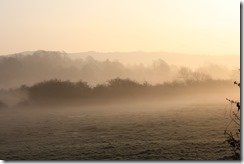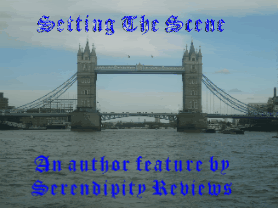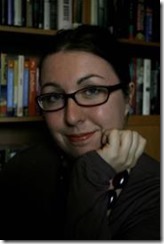On the blog today, I am really pleased to welcome back Ruth Warburton, who has recently published the third and final book in her Witch series. Ruth not only shares information about the Witch trilogy but she also gives us some details about her new secret project!
One of the things that many readers have commented on in reviews for my Winter Trilogy is the setting. Place is really important to me when I'm writing books - as important as the characters or the plot, and I guess that's reflected by the fact that although I toyed with a lot of titles for A Witch in Winter, eventually the one I settled on was the one using the name of the town. In the end of course, the whole trilogy would end up being named after Winter - although I didn't know that when I started writing.
For those who don't know the books, the story begins when 17-year-old Anna Winterson and her dad move to the small fishing village of Winter, on the south coast of England. When I started writing the Winter Trilogy I began with the character of Anna - but the first thing I did was set her on the road to Winter, and somehow the whole village just unfurled inside my head like a map unrolling itself.
Winter isn't a real place which enabled me to take a lot of liberties with the location. Many people have assumed it's set in the West Country, and I was definitely thinking of Cornish fishing villages like Mousehole and Padstow when I wrote the harbour scenes. But the Winter in my head was never located in the south west - but in an imaginary, unreal south east, close to where I grew up myself - a south east untouched by commuters and soaring house prices.
The south east fishing industry dwindled long ago, and the tiny fishing village of Brighthelmstone gradually morphed into the funky fashionable Brighton, helped along by the patronage of the Prince Regent and the gaudy gorgeous Pavilion he built. But you can still find the odd fishing boat with peeling paint on the shore at Brighton beach, a cluster of oyster pots hanging off a groyne. Beneath the clubs and the bars and the fashionable shops there is the ghost of an old fishing village and I think it was that place that I was trying to find when I imagined Winter.
To furnish my imaginary town I needed buildings and places. So I stole the castle from my home town of Lewes, ripped it out of the heart of the town and flung it down on the cliffs near Winter - the tumbledown walls and gap-toothed towers remained intact until I let my witches loose on them. I took the school where I went to secondary school, a former grammar school turned comprehensive, with memorial boards to the pupils who died in the great war in the polished entrance hall.
For those who don't know the books, the story begins when 17-year-old Anna Winterson and her dad move to the small fishing village of Winter, on the south coast of England. When I started writing the Winter Trilogy I began with the character of Anna - but the first thing I did was set her on the road to Winter, and somehow the whole village just unfurled inside my head like a map unrolling itself.
Winter isn't a real place which enabled me to take a lot of liberties with the location. Many people have assumed it's set in the West Country, and I was definitely thinking of Cornish fishing villages like Mousehole and Padstow when I wrote the harbour scenes. But the Winter in my head was never located in the south west - but in an imaginary, unreal south east, close to where I grew up myself - a south east untouched by commuters and soaring house prices.
The south east fishing industry dwindled long ago, and the tiny fishing village of Brighthelmstone gradually morphed into the funky fashionable Brighton, helped along by the patronage of the Prince Regent and the gaudy gorgeous Pavilion he built. But you can still find the odd fishing boat with peeling paint on the shore at Brighton beach, a cluster of oyster pots hanging off a groyne. Beneath the clubs and the bars and the fashionable shops there is the ghost of an old fishing village and I think it was that place that I was trying to find when I imagined Winter.
To furnish my imaginary town I needed buildings and places. So I stole the castle from my home town of Lewes, ripped it out of the heart of the town and flung it down on the cliffs near Winter - the tumbledown walls and gap-toothed towers remained intact until I let my witches loose on them. I took the school where I went to secondary school, a former grammar school turned comprehensive, with memorial boards to the pupils who died in the great war in the polished entrance hall.
![003KTOP00000042U017O0000[SVC2] 003KTOP00000042U017O0000[SVC2]](http://lh6.ggpht.com/-wCQxoZ81HN0/UTnoLIWoJoI/AAAAAAAAISU/qgbkwj25Qh4/003KTOP00000042U017O0000%25255BSVC2%25255D_thumb.jpg?imgmax=800)
I took the river too, the river Ouse that runs through Lewes and once, when I was growing up, flooded the town with a horrific, relentless quietness. It was a perfect storm of events - a high tide and on onshore wind combined to force water upriver from the sea. Above the town, heavy rain overwhelmed the villages upstream, until they opened their flood gates allowing the water to flow down towards the sea. The two tides met at Lewes - and engulfed the town, flooding my father's house a metre deep and destroying everything downstairs - from the contents of the freezer to his vintage record collection. As people who have read book one will know, that flood also found its way into Winter.

In many ways, the Winter trilogy is a love letter to Lewes and the area I grew up in, but after writing three books set in and around Winter, I knew that my next project was going to be set somewhere else - in the place I live now - London. But not quite the London where I currently live, for the two books I'm working on now are set in Victorian London, in the 1880s. The first book, Witch Finder, starts in the Spitalfield slums, home to my main character Luke, a working-class blacksmith, and moves to the fashionable west, to Hyde Park and Kensington and Piccadilly where Rosa Greenwood lives in relative affluence.

I'd never written historical fiction before and I knew I was giving myself a challenge in setting my characters loose on a place I'd never been and could never visit, because it disappeared 100 years ago, and as I wrote I found myself pondering all sorts of questions. How many blacksmiths were there in East London? What was it like to walk around in a "London Particular" - a pea-souper fog? Could well-to-do young ladies catch omnibuses? How was milk delivered?
But London is fantastically well documented, both in research documents and in novels, so the answers to most questions are there, if you search for long enough. It also helps that history in London is never very far below the surface of the present day. Wandering around the narrow dimly lit streets of East London it's very easy to imagine yourself back in Victorian times; some of the streets have barely altered although they are undoubtedly cleaner and less smoky than when Luke lived there. There are some huge changes of course - the clean air act has meant an end to the pernicious fogs that killed so many people, and it's very hard to imagine modern London without rivers of cars and buses roaring through it. In Luke and Rosa's time it was just as busy, with traffic jams that were just as irritating for commuters and travellers, but the vehicles were horse-drawn, and the horses had very different problems with refuelling and pollution.

The 1880s were turbulent times for London. The slum conditions in the East End were becoming critical - destruction of the slums and rookeries in the centre of the city had forced the homeless poor further and further east, exacerbating the crowded conditions that already existed in the East End. Workhouses were set up to try to combat the problem, but quickly became almost as feared as the streets themselves. With labour laws in their infancy, factories provided employment but in incredibly hazardous conditions, and the poor were often forced to choose between feeding their family and destroying their own health. But gradually a movement was coming together to protest these conditions - the match girls' strike of 1889 was not far off, and even among the rich there were rumblings of discomfort about what was going on in the eastern reaches of their city. It was in these conditions and these streets that Jack the Ripper was born, although he plays no part in my story.
All this forms the background to Luke and Rosa's story, Witch Finder, which is in many ways the story of the two halves of London fighting against each other yet inescapably intertwined and interdependent. I'm just starting to do the research for book two, Witch Hunt, and I can't wait to see where the characters will take me...
A Witch Alone by Ruth Warburton
To find out more about Ruth:




No comments:
Post a Comment
Hiya, thanks for stopping by, it is always nice to hear what you have to say, so do leave a comment if you have time.